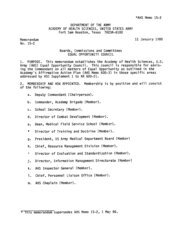Connecting BRAC with San Antonio ... - Fort Sam Houston
Connecting BRAC with San Antonio ... - Fort Sam Houston
Connecting BRAC with San Antonio ... - Fort Sam Houston
Create successful ePaper yourself
Turn your PDF publications into a flip-book with our unique Google optimized e-Paper software.
OCTOBER 8, 2009<br />
<strong>Connecting</strong> <strong>BRAC</strong> <strong>with</strong> <strong>San</strong> <strong>Antonio</strong>:<br />
construction activities at <strong>Fort</strong> <strong>Sam</strong><br />
(Source: Joint Program<br />
Management Office)<br />
Construction is at the peak of activity <strong>with</strong> over 50 projects currently underway at <strong>Fort</strong> <strong>Sam</strong><br />
<strong>Houston</strong>. As much as 65 percent of the post is behind a construction fence and that’s almost<br />
2,000 of the post’s 3,000 acres including roads and parking lots being resurfaced or repaired.<br />
This milestone means the number of construction workers and equipment on post will not be<br />
greater at any other time between now and the deadline to complete Base Realignment and<br />
Closure projects, September 2011.<br />
Roughly 2,200 construction workers are spread across project sites. Arrivals and departures of<br />
the workforce and ongoing delivery of supplies and materials amount to an estimated 4,000<br />
vehicle trips per day throughout the post.<br />
Largest Projects<br />
Brooke Army Medical Center is being expanded (760,000 square feet) and renovated (288,000<br />
square feet) to absorb military inpatient care and related specialty care services currently<br />
provided at Wilford Hall Medical Center. A new facility will replace Wilford Hall and be focused<br />
solely on outpatient care. Operations of BAMC and Wilford Hall will be combined, so that they<br />
function as the north and south campuses of a single complex as the <strong>San</strong> <strong>Antonio</strong> Military<br />
Medical Center.<br />
The Medical Education and Training Campus will include 1.9 million square feet of facilities at<br />
FSH that will integrate enlisted medical training programs (medics, corpsmen, radiology<br />
technicians, biomedical equipment specialists, etc.) of all military service branches. METC will<br />
be the largest training institution of its kind in the world <strong>with</strong> an average daily student<br />
enrollment of 9,000. Facilities include dorms, classrooms, labs, a dining facility, and a physical<br />
fitness center.<br />
METC Dining Facility, an 80,000 square-foot dining hall, is the largest in the U.S. Army’s entire<br />
inventory and one of the largest in the entire Department of Defense. The facility has seating<br />
capacity for 2,016 individuals at one time and is designed to feed as many as 4,800 personnel in<br />
a single, 1.5 hour dining period by rotating groups of several hundred through the facility in<br />
succession.<br />
The Battlefield Health and Trauma Research Center, slated for completion in the spring of next<br />
year, will be connected to the rest of the post via a bridge spanning Salado Creek.
A collection of historic structures are being renovated as office space to accommodate relocation<br />
of the Army’s Installation Management Command, that is expected to bring between 2,000 and<br />
3,000 positions to the post. Renovations to Buildings 2001 and 2007 are completed. Building<br />
2000 is slated for occupancy this fall. Building 2265 is slated for completion next August.<br />
The <strong>Fort</strong> <strong>Sam</strong> <strong>Houston</strong> Primary Care Clinic is scheduled to be finished late in the spring of next<br />
year. This clinic will provide routine health care services that will be displaced when BAMC is<br />
reconfigured as SAMMC North.<br />
Camp Bullis facilities<br />
The Camp Bullis Health Clinic is scheduled for completion in November. The Central Energy<br />
Plant is slated for completion in September of next year. The Armed Forces Reserve Center is<br />
finished.<br />
Economic Impact<br />
According to figures in a study commissioned by the City of <strong>San</strong> <strong>Antonio</strong> and posted on the Web<br />
page of the city’s Office of Military Affairs:<br />
• <strong>BRAC</strong> construction and related activities are projected to generate an overall economic impact<br />
of $8.3 billion<br />
• Additional sales tax revenue generated by <strong>BRAC</strong> construction through 2011 is estimated to be<br />
$10.4 million.<br />
After construction ends, increased activity on FSH is expected to produce an additional $4.9<br />
million per year in sales tax revenue<br />
• <strong>BRAC</strong> is projected to support the equivalent of 90,000 direct and spin-off jobs<br />
• This figure includes almost 62,000 jobs tied to construction activities (including suppliers,<br />
vendors, other supporting businesses), as well as roughly 28,000 jobs that would continue to be<br />
supported after construction ends. As many as 12,000 additional military and federal civil<br />
service positions expected at <strong>Fort</strong> <strong>Sam</strong> <strong>Houston</strong>.<br />
New Medical Education and Training Campus barracks are constructed using a modular design. A single module is two sets of two-man rooms, complete <strong>with</strong> living areas, walkin<br />
closets, and bathrooms. Modules are manufactured outside of <strong>San</strong> <strong>Antonio</strong>, shipped to <strong>Fort</strong> <strong>Sam</strong> <strong>Houston</strong>, staged on the post, then lifted by crane into place. Eight modules<br />
are placed per day.
















